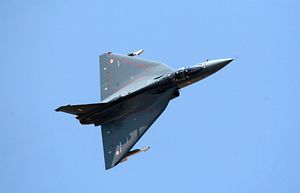India’s Tejas Light Combat Aircraft (LCA) program is encountering further delays, with final operational clearance postponed to March 2016, according to local media sources.
The supersonic, single-seat, single-engine multirole light fighter aircraft has been under development for the past three decades. The date for final operational clearance was originally December 2015. Final operational clearance implies that the aircraft can fire all of its weapon systems as well as undergo midair refueling.
The delay is due to “non-supply of newly designed quartz radome and a bolt on inflight refueling probe by Cobham UK,” defenseword.net reports.
Furthermore, tests of the French-made Beyond Visual Range (BVR) Derby — a medium-range active radar homing missile — scheduled to be held in May have been pushed back to July, Indian Ministry of Defense sources told local media.
The Tejas LCA, developed by the Aeronautical Development Agency in cooperation with Hindustan Aeronautics Limited (HAL), achieved initial operational clearance — i.e. was deemed capable of flying in all weather conditions — in December 2013, with the first aircraft handed over to the Indian Air Force in January 2015.
The Indian Air Force has placed an order for 40 Tejas LCA, including 20 Tejas Mark-I and 20 Mark-II aircraft. Originally, the Indian Air Force set its requirement at 200 single-seat Tejas LCA and 20 two-seat conversion trainers. The Indian Naval Air Arm requested 40 single-seaters. These numbers, according to the Times of India, are now down to 120 planes for the Indian Air Force but increased to 50 for the navy.
In May 2015, the Comptroller and Auditor General (CAG) of India – the Indian government’s principal oversight body – noted 53 “significant shortfalls” in the Mark-I version of the Tejas LCA, reducing operational capabilities and survivability, Economic Times reported.
“LCA Mark-I, which achieved Initial Operational Clearance (December, 2013) has significant shortfalls (53 permanent waivers/concessions) in meeting ASR (Air Staff Requirements) as a result of which it will have reduced operational capabilities and reduced survivability, thereby limiting its operational employability when inducted into IAF squadrons,” the CAG report said.
The report singles out inadequate electronic warfare capabilities, problems with the onboard radar system, as well as reduced internal-fuel capacity among a host of other issues, all of which should be rectified with the introduction of the Tejas Mark-II version of the aircraft.
Interestingly, the Indian Ministry of Defense is considering establishing a private-public partnership to fast-track production of the Tejas Mark-II. The Indian Air Force requires at least 80 Tejas Mark-II planes, according to Indian defense officials.
IHS Jane’s Defense Weekly notes that this “envisages the possibility of a private Indian company forming a joint venture (JV) with a foreign fighter manufacturer to reconfigure the Mk 2 with the more powerful General Electric F414-GE-IN56 engine.”
The first 20 Tejas Mark-I are slated for induction by 2017-18, whereas the Mark-II version is tentatively scheduled for the 2021-2022 period. Total program costs are expected to exceed 55,000 crore (approximately $8.6 billion).
The Indian Air Force has for the last few years been suffering from a shortfall in the number of trained pilots (See: “The Indian Air Force’s Big Problem: Not Enough Pilots”). In addition, the number of combat squadrons has fallen to 34 despite an authorized goal of 42.
One of the reasons for the decline in numbers is that MIG-21s constitute the bulk of India’s Air Force. However, the aircraft are rapidly being retired due to age and wear or are lost in crashes without adequate replacements available (See: “Indian Air Force Still Plagued by Poor Procurement Process”).































